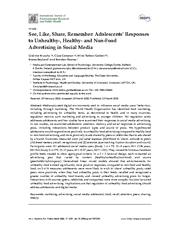A copy of this work was available on the public web and has been preserved in the Wayback Machine. The capture dates from 2020; you can also visit the original URL.
The file type is application/pdf.
See, Like, Share, Remember: Adolescents' Responses to Unhealthy-, Healthy- and Non-Food Advertising in Social Media
2020
International Journal of Environmental Research and Public Health
Media-saturated digital environments seek to influence social media users' behaviour, including through marketing. The World Health Organization has identified food marketing, including advertising for unhealthy items, as detrimental to health, and in many countries, regulation restricts such marketing and advertising to younger children. Yet regulation rarely addresses adolescents and few studies have examined their responses to social media advertising. In two studies, we examined
doi:10.3390/ijerph17072181
pmid:32218252
pmcid:PMC7177346
fatcat:2xqdp5xjz5fmrejyryj2kpom5m

